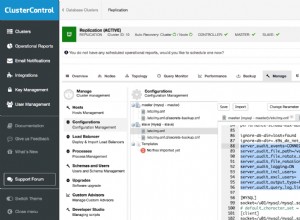@@ROWCOUNT dará el número de filas afectadas por el último instrucción SQL, es mejor capturarla en una variable local siguiendo el comando en cuestión, ya que su valor cambiará la próxima vez que la mire:
DECLARE @Rows int
DECLARE @TestTable table (col1 int, col2 int)
INSERT INTO @TestTable (col1, col2) select 1,2 union select 3,4
SELECT @[email protected]@ROWCOUNT
SELECT @Rows AS Rows,@@ROWCOUNT AS [ROWCOUNT]
SALIDA:
(2 row(s) affected)
Rows ROWCOUNT
----------- -----------
2 1
(1 row(s) affected)
obtienes Rows valor de 2, el número de filas insertadas, pero ROWCOUNT es 1 porque SELECT @[email protected]@ROWCOUNT comando afectado 1 fila
si tiene múltiples INSERTOS o ACTUALIZACIONES, etc. en su transacción, debe determinar cómo le gustaría "contar" lo que está sucediendo. Podría tener un total separado para cada tabla, un solo valor total general o algo completamente diferente. Deberá DECLARAR una variable para cada total que desee rastrear y agregarla después de cada operación que se le aplique:
--note there is no error handling here, as this is a simple example
DECLARE @AppleTotal int
DECLARE @PeachTotal int
SELECT @AppleTotal=0,@PeachTotal=0
BEGIN TRANSACTION
INSERT INTO Apple (col1, col2) Select col1,col2 from xyz where ...
SET @[email protected][email protected]@ROWCOUNT
INSERT INTO Apple (col1, col2) Select col1,col2 from abc where ...
SET @[email protected][email protected]@ROWCOUNT
INSERT INTO Peach (col1, col2) Select col1,col2 from xyz where ...
SET @[email protected][email protected]@ROWCOUNT
INSERT INTO Peach (col1, col2) Select col1,col2 from abc where ...
SET @[email protected][email protected]@ROWCOUNT
COMMIT
SELECT @AppleTotal AS AppleTotal, @PeachTotal AS PeachTotal




